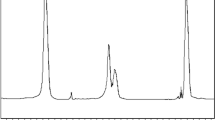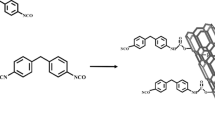Abstract
A series of novel covalently linked waterborne polyurethane/3-aminopropyltriethoxysilane/multiwalled carbon nanotube (WPU/Si/MWCNT) nanocomposites were synthesized through an optimized copolycondensation of hydroxyls. A multiwalled carbon nanotube (MWCNT) as the inorganic filler was pretreated with a successive two-step modification route for its surface function with hydroxyl groups. 3-Aminopropyltriethoxysilane (APTES) was embedded into the backbone of the WPU molecules, hydrolysis of which generates silanol groups in the polyurethane (PU) matrix at the emulsification stage. Meanwhile, the silanol groups could condense with the hydroxyl groups on the surface of the modified MWCNT, generating the covalent bond between the modified MWCNT and the APTES-embedded PU matrix. The change of surface composition of the MWCNT during surface modification process was characterized by using both Fourier transform infrared spectroscopy and X-ray photoelectron spectroscopy. The transmission electron microscope (TEM) was utilized to image morphology of the modified MWCNT. The field emulsion scanning electron microscopy (SEM) micrographs and particle size distribution curves showed that the modified MWCNT was well dispersed in the PU matrix. The thermal stability, water resistance, mechanical properties and dynamic mechanical thermal behaviors of the WPU/Si/MWCNT films were characterized by thermogravimetric analysis, swelling test, tensile test, and dynamic mechanical thermal analysis, respectively. These results revealed that compared to the pristine WPU, the WPU/Si/MWCNT system with APTES and the modified MWCNT possesses outstanding water resistance, high thermal stability and excellent mechanical properties.















Similar content being viewed by others
References
Pandey S, Goswami GK, Nanda KK (2013) Nanocomposite based flexible ultrasensitive resistive gas sensor for chemical reactions studies. Sci Rep 3:2082
Pandey S, Nanda KK (2016) Au Nanocomposite Based Chemiresistive Ammonia Sensor for Health Monitoring. ACS Sensors 1(1):55–62
Pandey S, Tiwari S (2015) Facile approach to synthesize chitosan based composite—characterization and cadmium(II) ion adsorption studies. Carbohydr Polym 134:646–656
Pandey S, Ramontja J (2016) Turning to Nanotechnology for Water Pollution Control: Applications of Nanocomposites. Focus Sci 2(2):1–10
Pandey S, Goswami GK, Nanda KK (2012) Green synthesis of biopolymer-silver nanoparticle nanocomposite: an optical sensor for ammonia detection. Int J Biol Macromol 51(4):583–589
Chou C-W, S-h Hsu, Chang H, Tseng S-M, Lin H-R (2006) Enhanced thermal and mechanical properties and biostability of polyurethane containing silver nanoparticles. Polym Degrad Stab 91(5):1017–1024
Ma X-Y, Zhang W-D (2009) Effects of flower-like ZnO nanowhiskers on the mechanical, thermal and antibacterial properties of waterborne polyurethane. Polym Degrad Stab 94(7):1103–1109
Stribeck N, Zeinolebadi A, Harpen F, Luinstra G, Eling B, Botta S (2013) Thermoplastic polyurethane cross-linked by functionalized silica. Nanostructure evolution under mechanical load. Macromolecules 46(10):4041–4052
Chen S, Zhang S, Li Y, Zhao G (2015) Synthesis and properties of novel UV -curable hyperbranched waterborne polyurethane/Fe3O4 nanocomposite films with excellent magnetic properties. RSC Adv 5(6):4355–4363
Hu X, Tian M, Qu L, Zhu S, Han G (2015) Multifunctional cotton fabrics with graphene/polyurethane coatings with far-infrared emission, electrical conductivity, and ultraviolet-blocking properties. Carbon 95:625–633
Gu J, Hu D, Huang J (2016) One-photosynthesis and control of aqueous soluble and organic soluble carbon dots from a designable waterborne polyurethane emulsion. Nanoscale 8(7):3973–3981
Ti Y, Wen Q, Chen D (2016) Characterization of the hydrogen bond in polyurethane-attapulgite nanocomposites. J Appl Polym Sci 133(9):6064. doi:10.1002/app.43069
Tien YI, Wei KH (2002) The effect of nano-sized silicate layers from montmorillonite on glass transition, dynamic mechanical, and thermal degradation properties of segmented polyurethane. J Appl Polym Sci 86(7):1741–1748
Xiao Y, Fu X, Zhang Y, Liu Z, Jiang L, Lei J (2016) Preparation of waterborne polyurethanes based on the organic solvent-free process. Green Chem 18(2):412–416
Zhang Y, Qi Y, Zhang Z (2016) Synthesis of PPG-TDI-BDO polyurethane and the influence of hard segment content on its structure and antifouling properties. Prog Org Coat 97:115–121
Liu N, Zhao Y, Kang M, Wang J, Wang X, Feng Y et al (2015) The effects of the molecular weight and structure of polycarbonatediols on the properties of waterborne polyurethanes. Prog Org Coat 82:46–56
Du Y, Zhang J, Zhou C (2015) Synthesis and properties of waterborne polyurethane-based PTMG and PDMS as soft segment. Polym Bull 73(1):293–308
Nikje MMA, Tehrani ZM (2010) Thermal and mechanical properties of polyurethane rigid foam/modified nanosilica composite. Polym Eng Sci 50(3):468–473
Lei L, Zhang Y, Ou C, Xia Z, Zhong L (2016) Synthesis and characterization of waterborne polyurethanes with alkoxy silane groups in the side chains for potential application in waterborne ink. Prog Org Coat 92:85–94
Nomura Y, Sato A, Sato S, Mori H, Endo T (2007) Synthesis of novel moisture-curable polyurethanes end-capped with trialkoxysilane and their application to one-component adhesives. J Polym Sci Part A Polym Chem 45(13):2689–2704
Bakhshi H, Yeganeh H, Mehdipour-Ataei S, Solouk A, Irani S (2013) Polyurethane coatings derived from 1,2,3-triazole-functionalized soybean oil-based polyols: studying their physical, mechanical, thermal, and biological properties. Macromolecules 46(19):7777–7788
Fang C, Zhou X, Yu Q, Liu S, Guo D, Yu R et al (2014) Synthesis and characterization of low crystalline waterborne polyurethane for potential application in water-based ink binder. Prog Org Coat 77(1):61–71
Michálek M, Bredol M (2013) Incorporation of functionalized multiwall carbon nanotubes into a polyurethane matrix. Adv Mater Sci Eng 2013:1–6
Zeng Z, Chen M, Jin H, Li W, Xue X, Zhou L et al (2016) Thin and flexible multi-walled carbon nanotube/waterborne polyurethane composites with high-performance electromagnetic interference shielding. Carbon 96:768–777
Wu Z, Wang H, Xue M, Tian X, Zhou H, Ye X et al (2015) Preparation of carbon nanotubes/waterborne polyurethane composites with the emulsion particles assisted dispersion of carbon nanotubes. Compos Sci Technol 114:50–56
Wepasnick KA, Smith BA, Schrote KE, Wilson HK, Diegelmann SR, Fairbrother DH (2011) Surface and structural characterization of multi-walled carbon nanotubes following different oxidative treatments. Carbon 49(1):24–36
Richter H, Treska M, Howard JB, Wen JZ, Thomasson SB, Reading AA et al (2008) Large scale combustion synthesis of single-walled carbon nanotubes and their characterization. J Nanosci Nanotechnol 8(11):6065–6074
Jiang S, Li Q, Zhao Y, Wang J, Kang M (2015) Effect of surface silanization of carbon fiber on mechanical properties of carbon fiber reinforced polyurethane composites. Compos Sci Technol 110:87–94
Yue S, Zhang Z, Fan X, Liu P, Xiao C (2015) Effect of 3-aminopropyltriethoxysilane on solvent resistance, thermal stability, and mechanical properties of two-component waterborne polyurethane. Int J Polym Anal Charact 20(4):285–297
Martín O, Gutierrez HR, Maroto-Valiente A, Terrones M, Blanco T, Baselga J (2013) An efficient method for the carboxylation of few-wall carbon nanotubes with little damage to their sidewalls. Mater Chem Phys 140(2–3):499–507
Vogler EA (2015) Structure and reactivity of water at biomaterial surfaces. Adv Colloid Interface Sci 74:69–117
Gutiérrez TJ, González G (2016) Effects of exposure to pulsed light on surface and structural properties of edible films made from cassava and taro starch. Food Bioprocess Technol 9:1812
Gutiérrez TJ, González G (2016) Effects of Cross-linking with Aloe vera Gel on Surface and Physicochemical Properties of Edible Films Made from Plantain Flour. Food Biophys. doi:10.1007/s11483-016-9458-z
Serkis M, Špírková M, Kredatusová J, Hodan J, Bureš R (2016) Organic–inorganic nanocomposite films made from polyurethane dispersions and colloidal silica particles. Compos Interfaces 23(2):157–173
Xiaojuan L, Xiaorui L, Lei W, Yiding S (2010) Synthesis and characterizations of waterborne polyurethane modified with 3-aminopropyltriethoxysilane. Polym Bull 65(1):45–57
Han Y, Chen Z, Dong W, Xin Z (2014) Improved water resistance, thermal stability, and mechanical properties of waterborne polyurethane nanohybrids reinforced by fumed silica via in situ polymerization. High Perform Polym 27(7):824–832
Gutiérrez TJ, Suniaga J, Monsalve A, García NL (2016) Influence of beet flour on the relationship surface-properties of edible and intelligent films made from native and modified plantain flour. Food Hydrocoll 54:234–244
Author information
Authors and Affiliations
Corresponding author
Rights and permissions
About this article
Cite this article
Fan, X., Zhang, Z., Yue, S. et al. Fabrication, characterization and properties of waterborne polyurethane/3-aminopropyltriethoxysilane/multiwalled carbon nanotube nanocomposites via copolycondensation of hydroxyls. Polym. Bull. 74, 2719–2739 (2017). https://doi.org/10.1007/s00289-016-1859-0
Received:
Revised:
Accepted:
Published:
Issue Date:
DOI: https://doi.org/10.1007/s00289-016-1859-0




